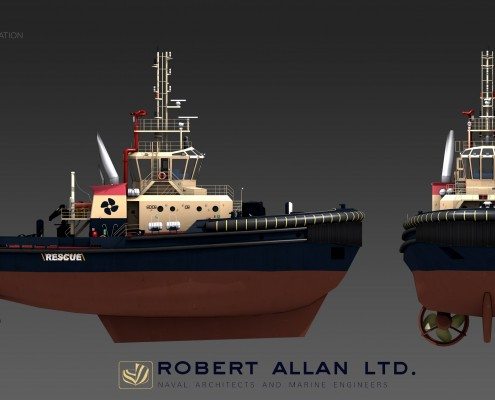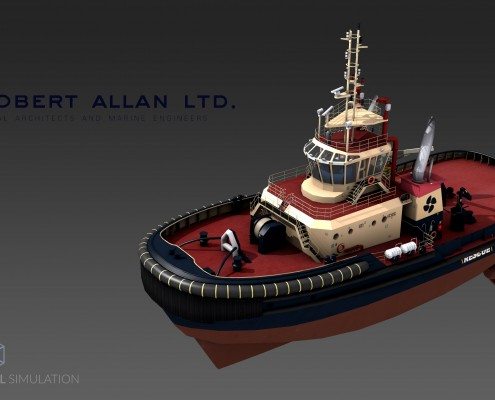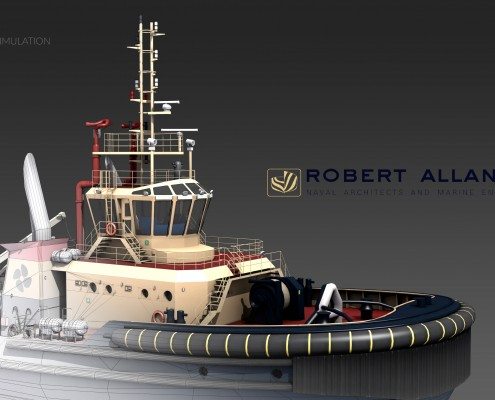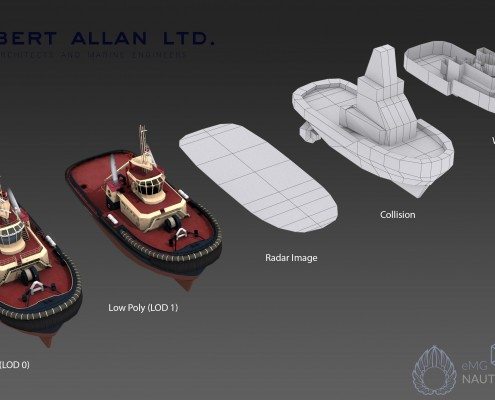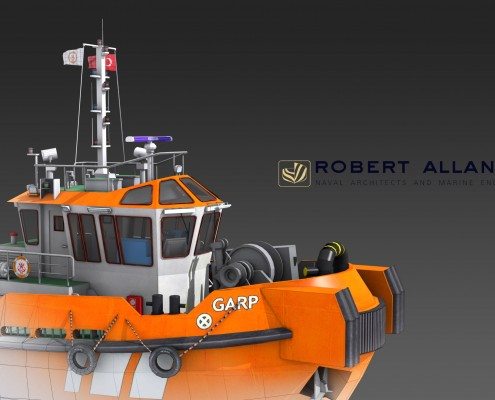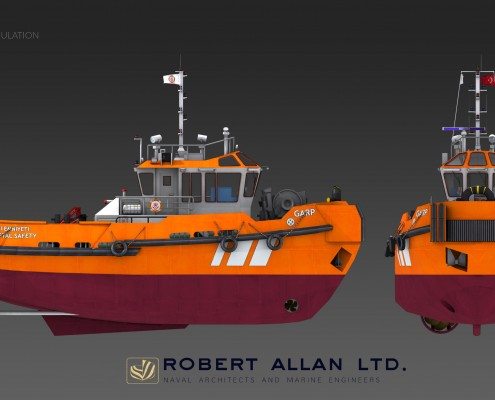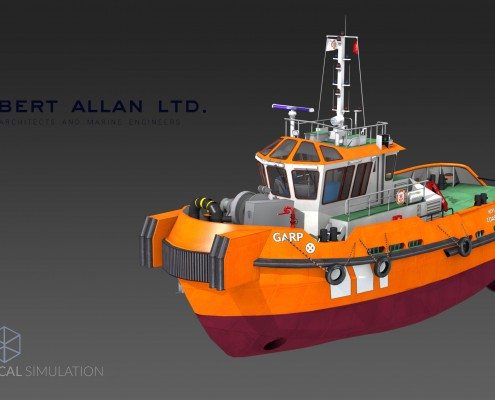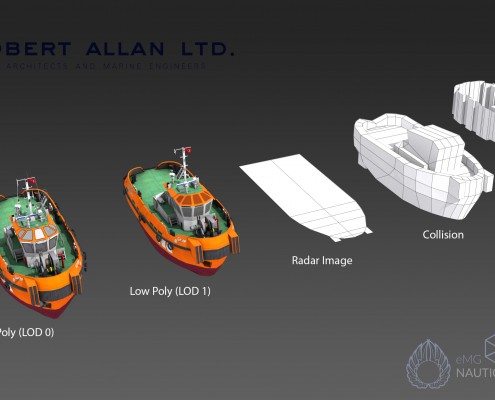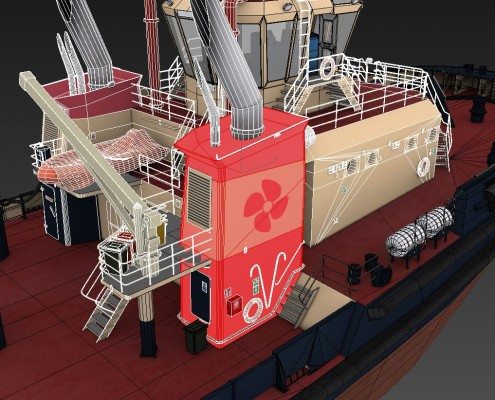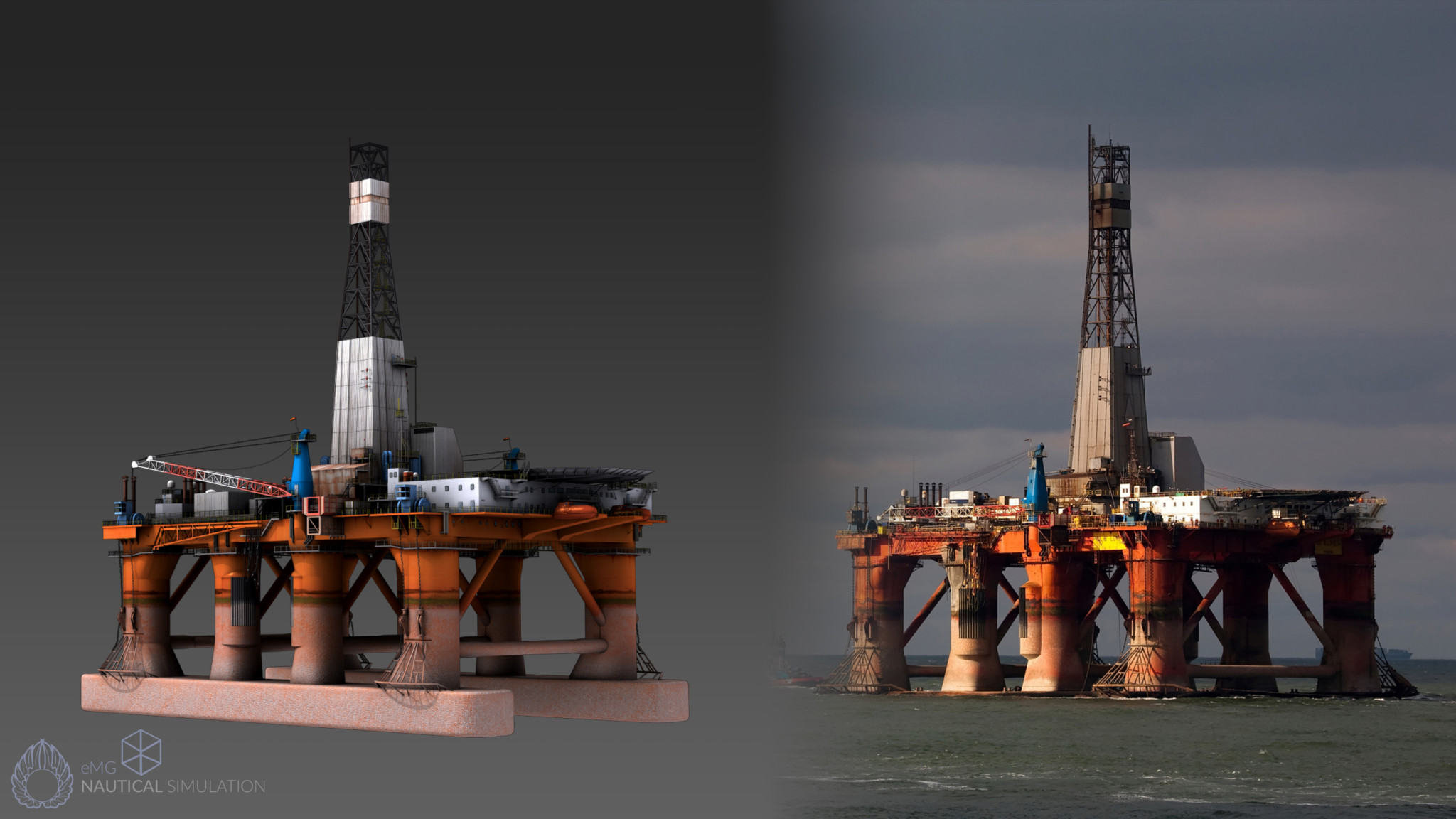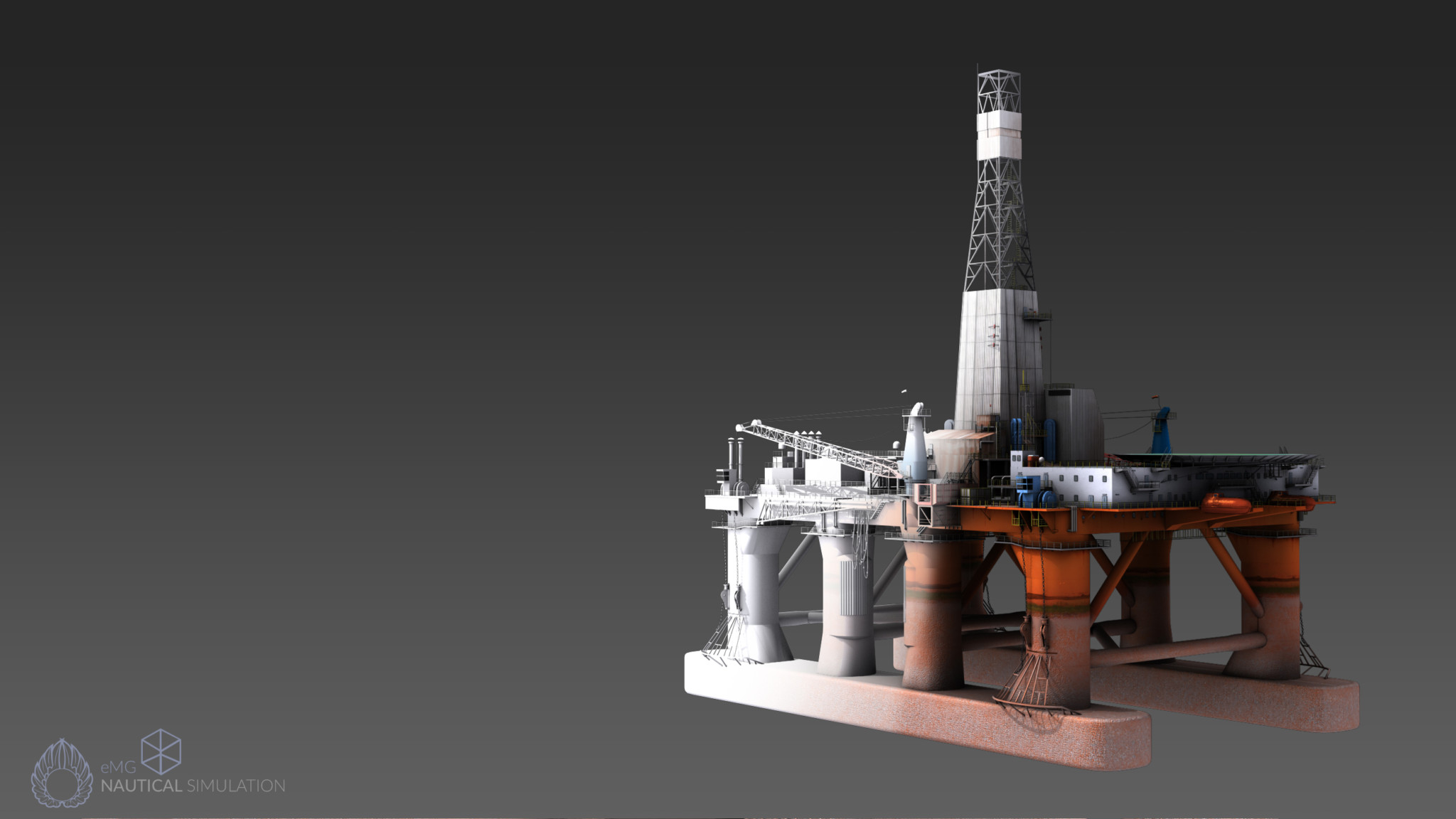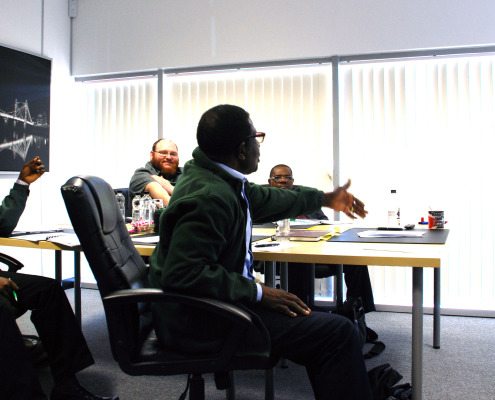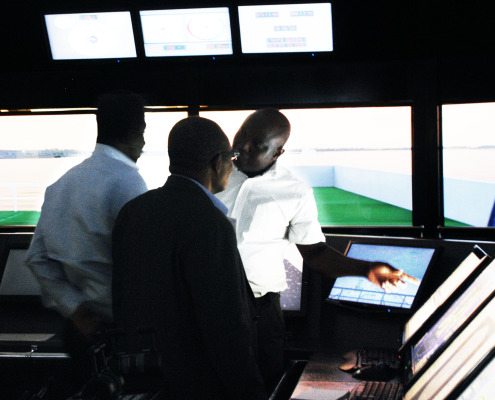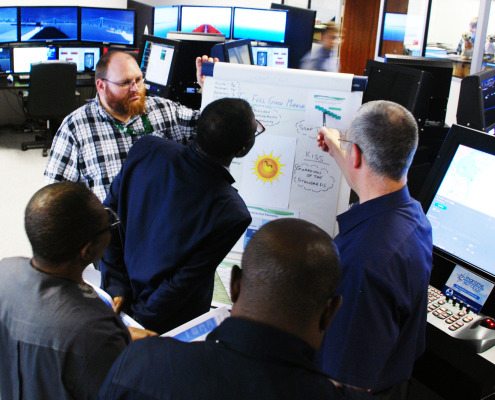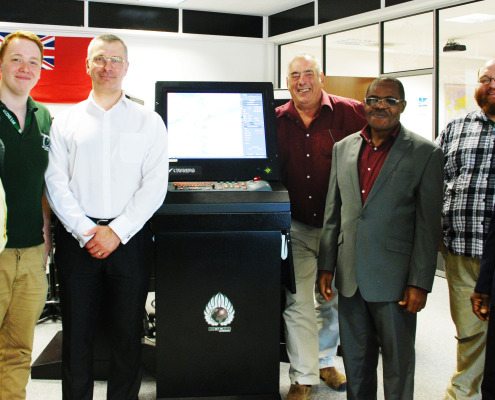ECDIS Ltd new 1.27 on-line and downloadable annual competency training
ECDIS Ltd new 1.27 online and downloadable annual competency training. Operators and Inspectors spotting a trend in gaps of seafarers basic knowledge in ECDIS.
ECDIS Ltd. and Robert Allan Ltd. work together on tug simulation project
ECDIS Ltd and Robert Allan Ltd team up to create simulated ship models.
When ECDIS Ltd were approached by a training organisation to create accurate 3D representations of two real life Robert Allan tug boats the first thought was to get the tug designers involved. The first stage to any modelling project is reference gathering and by working with the good people at Robert Allan Ltd we were able to gather all the necessary information we needed to accurately create the vessels.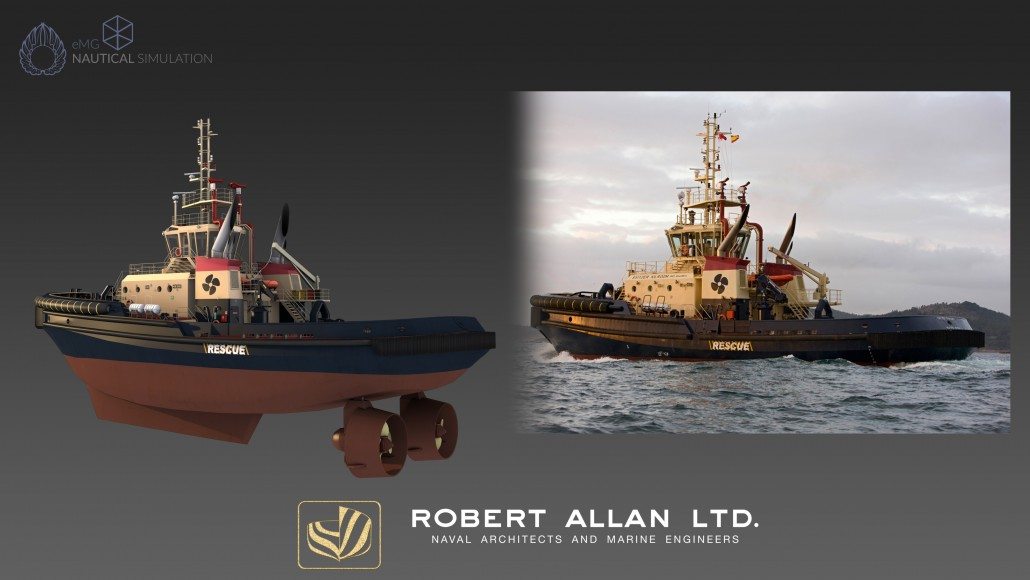
Once all the reference had been obtained it’s onto the 3D canvas, ECDIS Ltd use Autodesk 3DS Max modelling tool (used by top industry professionals from the video games and films industries) to create all their 3D models.
After around 1 – 2 weeks of modelling and texturing the finished model is ready to be integrated into the simulation software along with all the hydrodynamic data supplied directly from the source, Robert Allan Ltd.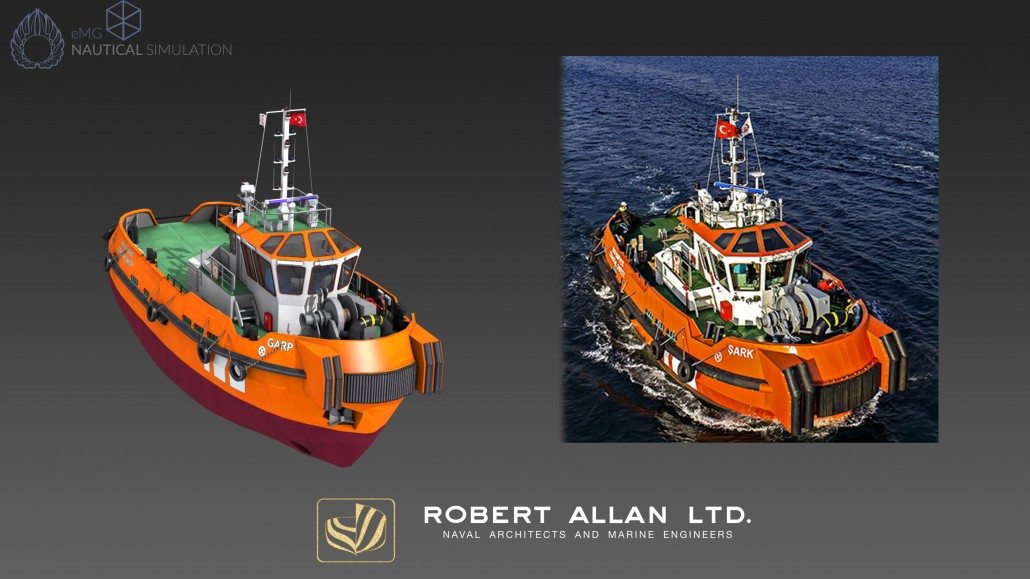
The finished article is ready to be used in a wide variety of tug boat training scenarios, everything from ship handling and manoeuvring to push and pull exercises.
Jack Osborn, Lead 3D Artist “It was a big task to accept, with a lot of responsibility to get this right. The look and feel of a simulated vessel is what ultimately makes the student take the simulation seriously so we had to insure the vessels looked and felt as real to life as possible and who better to help us than the real tug designers. None of the work could have been completed without all the help and generosity from the people at Robert Allan Ltd and on behalf of ECDIS Ltd I would like to thank them for all their help.”
For more information about our services please visit our Nautical Simulation website
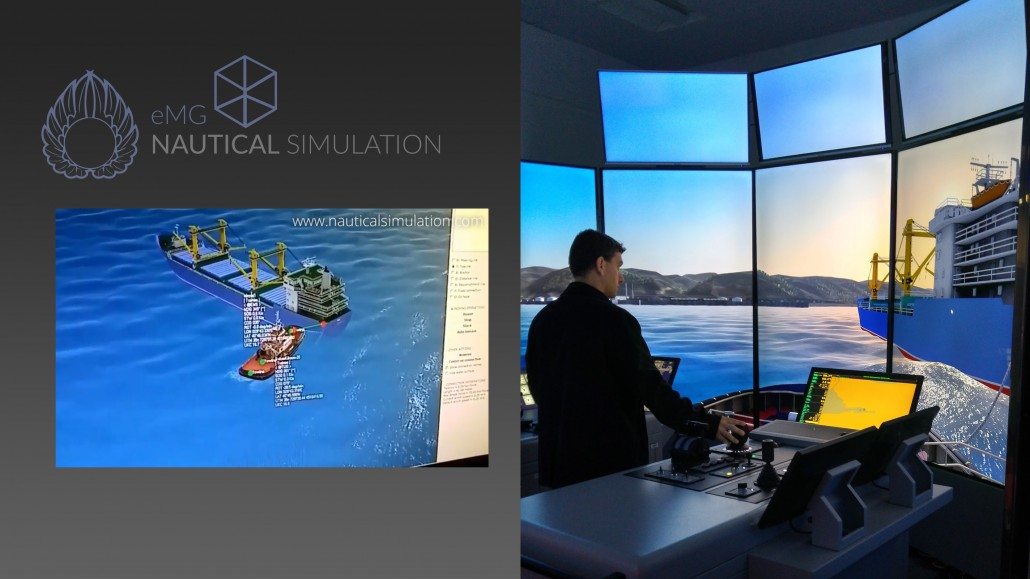
Video: ECDIS Ltd’s Joe Celebrates His 50th HELM Course
Our HELM instructor Joe Sloly is celebrating his 50th HELM course here at ECDIS Ltd. Here he explains a bit about what the HELM course is and it’s importance.
For more information please visit https://www.ecdis.org/helm
Video produced by Samantha Hucklesby and edited by Mike Backhouse.
New Offshore Drilling Rig Scenario – ECDIS Ltd
Following on from the recent off shore wind farm scenario development ECDIS Ltd are proud to announce a new training environment created by the 3D development team. The environment is based around a large off shore drilling rig and has been created to give the instructors a new theme to base their exercises from.
Jack Osborn the Lead 3D Artist at ECDIS Ltd – “We had a big brain storming session after the off shore wind farm project and we asked ourselves what other environments could we create that would give our instructors something new to base their exercises around. This new off shore drilling rig environment all be it similar to the off shore wind farm environment will give our instructors a completely new set of ideas to base their exercises from and base their learning objectives around.”
Nick Harding Lead Instructor at ECDIS Ltd – “Having an off shore drilling rig environment gives us teachers many new possibilities to think about when designing exercises for the students to be put through. I think the first exercise I will be looking to create will be an exciting accident and emergency scenario filled with drama and unexpected events to keep the students on their toes.”
The environment has been designed for use in BTM, BRM and even some passage plan exercises for our other courses. ECDIS Ltd trains many oil and gas crews from around the world and it is hoped that this new environment will help make simulation training more relevant and relatable to their work. If you have a need for training in a specific area or scenario then please do get in touch to see how ECDIS Ltd could help you.

Jack Osborn
Video: ECDIS Ltd – Building a simulator complex in 7 days!
We recently installed a full bridge simulator suite in Istanbul, Turkey in just 7 days. Consisting of 2 mini sims, 1 enhanced mini sim, a full mission tug simulator and instructor station. All communicate within the same scenario, enabling extensive real-life training scenarios in a safe environment.
For more information please visit http://www.nauticalsimulation.com
Images and video taken by Mark Broster, Rudo Walinga and Neil Savage. Video produced by Mike Backhouse
Moving with the industry: Simulating Offshore Wind Farms
Our team of 3D artists have been working hard to create ECDIS Ltd’s first simulated generic wind farm environment. Based off the real life Kentish Flats wind farm near Margate the new environment will give our instructors a new area to base exercises from adding fresh ideas to their simulated scenarios…
The Importance of Continuous Professional Development
As a Navigational training academy, Continuous Professional Development (CPD) is a key message ECDIS Ltd instructors stress to our students. We know that while students are here with us they are at the top of their game with all that knowledge fresh in their minds, exercise books in hand and instructors on call.
As soon as they leave us at the end of the week, if not used, practised and developed that knowledge dwindles. Sometimes instructors can see that new familiarity growing smaller in the students’ eyes as Friday afternoon carries on. CPD is an essential part to any seafarer’s professional career, and many may be carrying out CPD naturally. However CPD is recommended to be formalised in one way or another.
ECDIS training is something that needs to be continually refreshed. People can often use the same common skills they need and forget the full capability of the ECDIS and also themselves. As it is a practical skill; practise and familiarisation with the ECDIS is essential to keep competency levels high. But without an instructor on hand setting exercises it can be difficult to know what to do.
A specific ECDIS CPD log equipped with theory, practical exercises, questions and answers is a handy way to keep on top of – and prove – your CPD. Complete the sections in groups and learn from each other or tackle them and test yourself.
In this quickly developing, forever changing and relatively new field of expertise, years of experience can count for nothing; particularly if that person can only demonstrate one repetitive skill exceptionally well.
Not all ships can guarantee or even provide internet access, and so old fashioned means should be relied on. An ECDIS CPD log is a neat, organised and useful means of maximising retention of knowledge with a filofax feel. Leather bound and purpose built to keep everything together.

Simulation and Its Usefulness as a Training Aid
ECDIS Ltd has delivered training using simulation since its inception. The Full Mission Bridge, Inspector Stations and Individual Desktop Simulators are an integral part to everyday training at the ECDIS Ltd Facility. Robyn Harrigan, Training and Production Manager and Nick Harding, Lead instructor, explains simulation and its usefulness as a training aid…
At ECDIS Ltd the use of the bridge simulators allows the instructors the dynamic ability to continuously change the COLREGs situations, in a variety of meteorological conditions, from any aspect for over thirty types of vessels, which is quite frankly incredible as a teaching aid. The technology behind these systems now are extraordinarily complex, using an efficient physics engine for water simulation and seabed collisions, all packaged together in an easy to use drag and drop style of play. In the hands of our instructors, this is an extraordinarily powerful tool, giving the ability to create fresh teaching exercises within minutes and demonstrated in real time.
This can be used to give trainees an understanding of critical situations and how the appropriate manoeuvres should look, not only from their own ship, but also how the same situation would, could and should look from other vessels viewpoints. As many trainees fear of getting it wrong in the work place, practising their underpinning theory knowledge from the classroom in a real life mimic simulator does allow confidence to grow and elevates the students skills to another level, in a risk free, blame free environment, allowing the students to hone their skills, discuss their bad habits and share good ones. Learning from your mistakes is a critical part of any learning experience, our bridge simulators allow you to do this in a safe way.
Furthermore by running scenarios through a simulator not only trains our future operators and managers it is also an excellent instrument for highlighting the importance of health and safety procedures, implementing new SOP’s, mitigating risk and the ability to capture new knowledge and to transfer it forwards to others in the maritime industry. Moreover at ECDIS Ltd the simulator instructors find that it is not just the students who are undergoing training, the instructors are also continuously learning, new approaches, different techniques and that Practise Makes Perfect.
“Modern ship bridge simulation provides a cost effective, safe means of raising the professionalism of ship navigating officers and identifying those who could benefit from further training. You can give someone a task that you would never risk with a multi million pound ship, and if they screw up the only thing that gets damaged is that person’s ego. Then they have the opportunity to practice the same scenario over and over again until they have perfected their skill.”
– Nick Harding | Lead Instructor at ECDIS Ltd

Training the Simulator Trainers for the Real World
We are still Training the Trainers, this time in the simulator.
From the 6.09 course this time last month, to the 6.10 Train the Simulator Instructor and Assessor course last week, our instructor, Joe Sloly delivered the 6.10 as an ECDIS Ltd first.
Whilst delivering the IMO 6.10 Train the Simulator Instructor and Assessor course the main thing I am taking away is the how complex building lessons/courses that meet with the STCW competency based principle of training can be. Having gone through the process in granularity with my students it also identified to them very early on why it is important to get this process right at the beginning of any Technology Based Training and the pit falls if you don’t.
Lecturers here in the UK and overseas I feel would benefit from attending this competency based training package. This would help breed out bad habits and replace them with effective skills helping us all in delivering cost effective and dynamic training programmes to our industry.
I welcome this opportunity having successfully completed both the IMO 6.09 and now the IMO 6.10 course to be able to deliver the courses myself to students in the coming weeks and months and play my part in making our industry an even safer industry to work for.

Delivered lectures and instruction to a wide range of students from company CEO’s to deck hands since 1996.
Courses Joe currently delivers at ECDIS Ltd:
- HELM
- Training Course for Instructor
- Simulation Instructor Course
ECDIS Ltd – Training The Trainers
ECDIS Ltd carried out and completed their first 6.09 Instructors ‘Train the trainer’ course at the beginning of June and since then has received the official rubber stamp of approval from the MCA. One of our ECDIS Ltd instructors, Richard Sloly (although we all call him Joe) attended the training and so can hold his 6.09 certificate up high, here he talks about his week on the course.
Having uploaded a blog several weeks ago about teaching tips for instructors based around a number of years of experience, I enrolled on the new IMO 6.09 Training Course for Instructor to further advance my skills and was pleasantly surprised by how much I learnt. I thought that I had a well honed lesson construction and delivery style going on. Having successfully completed the course, I learnt very valuable lessons that I will bring to bear whilst delivering the HELM (M) and (O) courses as well as ALL other lecturing opportunities.
I think that one of the main things that I am taking away is the how complex building lessons/courses that meet with the STCW competency based principle of training can be. Having gone through the process in granularity and seen my lesson plan evolve, it identified to me why it is important to get this process right at the beginning in order that continuity of lesson delivery is not lost or diluted between different instructors that deliver the same package of training. I liked the idea behind conducting meaning full `Energisers and Icebreakers`. To me these used to be things that were very pink and fluffy and carried no real importance… how wrong I was. This is something that I will utilise more during my course delivery from this point on as I saw firsthand how these exercises add value to the whole teaching and learning experience.
Lecturers both here in the UK and overseas I feel would benefit from attending this competency based training package. This would breed out bad habits and replace them with effective skills helping us all in delivering cost effective and dynamic training programmes to our industry. No matter how much the IMO comes out with new course and the accrediting bodies police them, we as instructors are in fact `The Guardian of the Standards` and we have a duty, no, a real opportunity here to play our part and provide properly trained mariners to the coal face.”
I welcome this opportunity; having successfully completed the IMO 6.09 course to be able to deliver the course myself to students in the coming weeks and months.

Delivered lectures and instruction to a wide range of students from company CEO’s to deck hands since 1996.
Courses Joe currently delivers at ECDIS Ltd:
- HELM
- Training Course for Instructor
- Simulation Instructor Course
5 Hints and Tips on Chart Purchasing
Chart Purchasing – Start here!
Choosing the right ECDIS system from the array of types and costs available often feels overwhelming, but it is only half the story. If you’re considering (or reconsidering) your current Chart Purchasing strategy, try starting with these tips;
1) Be comfortable with the terminology
Struggling with the terminology used to describe charts is an industry-wide problem. Get it wrong and not only are you in danger of receiving a product you didn’t really want or need, you are also in danger of failing to meet SOLAS Carriage Requirements for your vessel.
This centres on the use of S-57 vs ENC. An ENC is what the IMO recognise when it comes to carriage requirements in ECDIS-fitted ships and, whilst it’s true that all ENCs are compliant with the IHO S-57 standard, that doesn’t mean all S-57 charts are ENCs.
Let me explain. IHO S-57 Standard (Transfer Standards for Digital Hydrographic Data) is not the only pre-requisite of a chart being accepted as an ENC; the chart must also comply the IHO Standard S-52 and be issued by a Government authorised Hydrographic Office. Commercial charts may not meet this requirement at all.
Be sure you know what you’re ordering – if it doesn’t state that it’s an ENC, chances are that it’s not.
2) Know how you want to handle updates
Updates received by CD/DVD tend to be cheaper by virtue of not using satellite bandwidth. They also ensure that the bridge team will have a ready supply of updates at their next port should the most recent disc not arrive or work for any reason (each disk contains cumulative updates for the last 18 months). However, this method is prone to delays and arriving all at once can place an extra time burden for your watchkeepers – especially when they have multiple ECDIS units to consider.
Receiving automatic (via satellite) updates means never waiting for another update, plus greater freedom of choice for when updates are applied. Thanks to reducing costs for bandwidth and the small file size of ENC updates (limited to 50kb total before a chart is reissued) the costs of automatic updates are falling.
Choosing which method you have for receiving updates is more than just a cost consideration; consider the time constraints of the bridge team too.
3) The coverage isn’t as bad as you think…
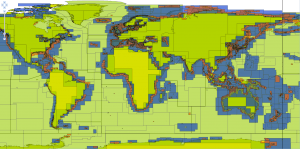
Rumours abound over the state of ENC coverage but the picture is much improved from five years ago (see right – correct as of July 2014). Give careful consideration to your requirement (if any) for paper charts. Maintaining both paper and ECDIS outfits massively increases the time requirement, and the skills required for the use of ECDIS/paper charts are deceptively perishable. Many ships/operators have conducted risk assessments that have enabled them to dispense entirely with paper charts, and thus do not have the outlay for Raster Charts and the subsequent paper chart backup.
Ensure the urge to carry Raster Charts driven by requirement and not the reluctance to let go of the old Chart system.
4) Be aware of the issues surrounding ENCs and the Presentation Library
Each cell (individual ENC) released by your Chart provider is identical regardless of which system you are using. Once you install it on to your particular ECDIS, it is converted to a System ENC which it can then read and display as required. The danger here is that not all systems are yet able to display the information correctly.
This isn’t as terrifying as it seems, though it will need careful management. With the correct procedures at the route planning stage, and with the continuous professional development of your bridge teams (they are undertaking ECDIS CPD, right…?), these risks can be successfully mitigated.
If you’re unaware as to how this will affect your particular ECDIS system, head over to the Dataset Check page on the IHO page and follow the instructions there. It’s a simple check of two ENC’s that are downloaded, and will give you confidence of the ability of your system to display the correct symbology and recognise relevant dangers. It also contains advice on procedures should your system not quite (yet) meet the grade.
The Dataset Check is a vital tool in understanding potential risks in your system.
5) Draw on experience
This extends to more than just the experience of your bridge team. The ECDIS transition is no longer in its infancy; there is a wealth of experience from people who have experienced the growing pains with procedures and documentation if you know where to look. Engaging with them will enable you to sidestep many of the problems they have had to overcome.
Seeking consultancy can avoid long costly hours of ‘feeling your way’ writing your own procedures and supporting documentation.

Dave is a navigating officer with an in-depth knowledge of operating ECDIS systems and experience of teaching a broad range of maritime subjects.
4 Hints and Tips Towards Better Teaching Techniques
Having to deliver or even attend training courses that are by their very nature defined as ‘dry and boring’ can be fuelled by the fact that the lessons are full of statistics and definitions or where lecturers have got it horribly wrong during lesson planning. Some of the tell tale signs are:
- Too many PowerPoint slides (The moment a student picks up on this it will usually drive fear and dread in to their hearts and will hinder engagement).
- Over use or poorly measured colour schemes on slides
- Over use of transition.
- Bad PowerPoint technique and timing (Jumping in and out of slides and presentations)
- Skipping slides
So, are we going to just accept that some lessons are very dry and as an instructor just plough through the lesson and get onto more interesting lessons, or, is it possible to look at maybe a different approach to the delivery? When I say different approach, I am really talking about engagement with students. Standing at the front of a course and regurgitating stuff from a folder, book or tablet can be counter-productive. Some lessons will be dry and boring, but by approaching this kind of lesson differently, it is possible to embrace these lessons and get as much out of them as possible from more interactive ones.
Here’s how:
1) Use Andragogy
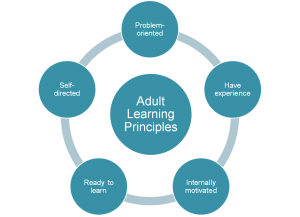
I have found that as an industry we tend to go for a pedagogy approach to training where an instructor/lecturer stands in front of the lesson and reading the lesson. I have experimented with using ANDRAGOGY for the last 24 months were I have worked hard to engage students and foster a relationship whereby they want to learn…..simple as that. If we want to do something then we are going to do a better job and I think that this applies to learning, if someone feels valued and part of the experience they will learn better and the retention of knowledge has more of a chance.
However, is ANDRAGOGY just a lazy instructor? In my opinion NO. In our industry now we need cognitive input from ALL within the industry, therefore, we are employing intelligent personnel, gone are the days whereby we may have worked with individuals that were academically challenged. a lazy instructor or a 21st century approach to training.
2) Set The Scene and Revisit Often
During introductions at the start of conferences and lectures, the intro tends to be usually short and I have experienced it were it has been presented as a non-thing!! To me, this is possible the most important part and by getting this right, to me it feels like people waiting outside a door not sure whether to go in or not. By getting the intro right and allowing students to hypothetically walk through the door into the lesson, they will feel part of the experience, at ease, want to interact and many other positive effects. I have achieved this by avoiding standing behind lecterns at all cost. By coming out where possible to the centre of the classroom or removing as many physical barriers between you and the students kind of puts you in there world, so whilst the instructor, you are delivering the lecture on and even footing.
On completion of a lesson, naturally I provide a link to the following lesson, I have found value at this point to refer back to the intro and the reason for the course. This supports the value of the whole course and as a class you can link the entire course content together and by cross referencing content you can establish value in all parts of the course. I have also found that naturally you have to teach stuff in chunks, by constantly referring and cross referencing lessons you are not just ploughing through content and not using the information that you have spoke of.
3) Allow Your Students To Teach (Mastery)
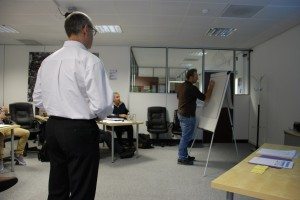
I have heard, and am a strong believer that the best way to learn is to teach. As you can see from this picture, I encourage students where possible to present to their piers their findings, opinions, understanding etc. This supports understanding of what you are trying to impart and will help students retention. Going back to a previous statement, this is why it is so important to spend the right amount of time on the intro and break down the lazy pedagogy barriers and maybe look at a twenty first century way of delivering instruction through ANDRAGOGY.
4) Display Course Aims During Revision Periods
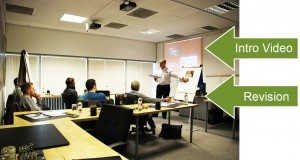
During revision periods I have found that displaying the course aim in the background whilst talking about the lesson content in the fore ground can help in linking the whole lesson together. On our HELM course, as part of the intro lesson we have a short video that completes the whole setting of the scene. When we complete a lesson we write it on a display board and we use this to refer back to. Whilst I do this I have the video running in the background and this helps me maintain the value of what we are talking through.

Delivered lectures and instruction to a wide range of students from company CEO’s to deck hands since 1996.
Courses Joe currently delivers at ECDIS Ltd:
- HELM
- Training Course for Instructor
- Simulation Instructor Course
What is the effect of the recent drop in oil prices on the shipping industry?
Nearly all merchant ships use oil in some form for their main engines and for generating electricity. Fuel costs are a major element of the running costs of a ship. For example over the last 6 months the price on the Rotterdam market for low sulphur 380 cst has fallen from about 630 US Dollars to in the region of 230 USD Similarly Marine Gas Oil has gone from 880 US Dollars to about 460 US Dollars. When consumption is measured is tens of tons per day the saving on a four week voyage can be considerable. This can lead to increased profitability for the shipping company and/or a reduction in freight rates which will act to boost the amount of cargo carried.
We are already hearing people on the television news talking about their reduced fuel costs. Some are talking about using their cars more. Alternatively this leads to more disposable income. If that allows increased spending in the shops there will be a rise in shipping traffic to restock the shops with imported goods.
Similarly reduced shipping costs can act as a boost to the national ability to earn foreign currency through exports.
Most countries have oil stock reserves, when the price of oil is low it is a golden opportunity to increase the amount of oil and Gas held in reserve thus increasing oil tanker traffic to import the oil. Interestingly this has not happened yet. There are a lot of Gas tankers, and no doubt oil tankers too, lying idle. The explanation is that the importers are delaying buying stocks until the prices have reached their lowest. Watch this space, idle tonnage may easily get chartered very soon.
The offshore Oil exploration industry is going through a downturn because of the cost of exploration being greater than the likely return from oil found. This obviously has a negative effect on places like Aberdeen and employment in the offshore industry in general. Quite how deep or long term the down turn will be is a bit of an unknown. This is particularly so because of the length of time it takes to discover new oil deposits and put in place the necessary infrastructure before any oil flows. The oil majors have to look several years ahead. It often appears that cutting back on staffing levels and thus costs is the easiest policy when belts have to be tightened; but is it the best decision for the long term prosperity of the company?
Interestingly in their recent “energy outlook” BP said:-
“After three years of high and deceptively steady oil prices, the fall of recent months is a stark reminder that the norm in energy markets is one of continuous change,” said Spencer Dale. “It is important that we look through short term volatility to identify those longer term trends in supply and demand that are likely to shape the energy sector over the next 20 years and so help inform the strategic choices facing the industry and policy makers alike.”
Their CEO Bob Dudley went on to say:-
“The energy industry works on strategies and investments with lifespans often measured in decades. This is why an authoritative view of the key trends and movements that will shape our markets over this long term is essential… and is precisely why this Outlook is so valuable.”
With the exception of the offshore industry, in the short term the downturn in oil prices should generally be beneficial to us, the shipping industry and the nation. Perhaps we should make the most of it whilst it lasts?
Article Reference Link: http://www.green4sea.com/bp-energy-outlook-2035-growing- gas-shifting-flows/

I have been a navigating officer in the Merchant Navy, Coastguard and been involved in Harbour Management. Since 2004 I have taught in the Maritime training field and become a qualified teacher.
The Future of Marine Simulation
For many years the aviation community has embraced simulator-based training as an integral part of teaching syllabi; not as a replacement for time in a real aircraft but to augment and consolidate theory, practice procedures and to push students’ capacity to a degree perhaps not possible in a real aircraft due to the risk inherent in willingly making things go wrong in the air.
Perhaps the collective inertia to integrate and exploit simulators for marine training is finally being overcome with the advent of a new generation of simulation technology. ECDIS Ltd is leading the world in reducing the gap between what training is possible at sea and what training is possible ashore. Through smart integration of existing, but extremely high-end hardware, ECDIS Ltd is able to provide 360° high definition bridge simulators of a quality and realism that has not been seen before. From the perspective of the end user this technology offers training with tangible benefits and at a fraction of the cost, and risk, of conducting such training at sea. Offering bespoke and importantly, flexible simulation solutions, ECDIS Ltd are constantly pathfinding and continue to set the standard of what is achievable in a simulator; solutions that have previously been thought of as unachievable, cost prohibitive or plain untenable are being made a reality. Consider the utility of a full mission bridge modelled on your own fleet of vessels, with the same equipment fully integrated and linked to a series of smaller simulators used to practice tug manoeuvring or counter-piracy tactics. The options and variety of training are no longer limited by technology as boundaries continue to be pushed and inventive, elegant solutions provided by a team of extremely dedicated technicians.
The desire to constantly improve doesn’t end there; complex equipment such as this needs regular and effective maintenance routines. Remote access has been utilised in the IT sector for several years and has now been tested and verified as a viable option for update and upgrade of such simulation technology. Issues can be diagnosed and resolved from many time zones away saving all-important time and ensuring training facilities remain open and fit for purpose. Where this is not enough; rapid deployment of a technician with a targeted aim is completed and problems are addressed in short order. This type of bespoke support and communication is not something found everywhere and sets ECDIS Ltd apart from competitors.
Advances will continue apace. Bridge simulators are not the boundary; this technology can be tailored to many fields and benefit many industries. Consultation with the team is free; we’d be happy to discuss simulation requirements and how we can assist in improving your training.
About The Author

Video: ECDIS Ltd 3D Department – Modelling The Future
We’ve uploaded a new video to YouTube. Find out all about our 3D Department at ECDIS Ltd. From Port & Vessel creation, to full mission bridge simulator designs and visualisations; our team are dedicated to producing state of the art simulation for training environments.
Produced by our own Ben Climas and featuring Jack Osborn, our Head of 3D Department…
Redesigning The ECDIS Ltd Website
Improving the ECDIS website was one of the original priorities I had when I first started here back in April last year, although it soon became clear that we wanted to do a bit more than just improve the site and it was in August 2014 that we decided to fully redesign it.
We wanted to “go against the flow” of other maritime training sites, and create a clean, open, spacious site, with a modern design and a colour scheme to tie in with our corporate theme. We also created a colour scheme for the courses in the new brochure and wanted to reflect that on the site.
The website has had several changes; however the first major stage only took around a month, as the majority of the content was already there. We’ve been live with the new site now for around 4 months, although there’s been a lot added to it since the initial visual re-design in September 2014. One of the main reasons for changing the design of the website was that the previous version wasn’t compatible with expansion. The latest update to the site followed the completion of the 2015 courses, products and services brochure, which included a large range of new courses developed for the New Year.
Over the next years we plan to constantly expand the site, adding videos and mini sites all within the main ECDIS website. We are currently designing mini sites for both the Port Creation and Simulator Builds which will independently stand alone, separate from the main site, but will both follow the design and feel of our current site.
About The Author

I am a web geek, with a love of art & design, and have been designing websites for over 10 years. With the stereotypical loves of Star Trek and other sci-fi, I also play the saxophone in my spare time, love jazz and am actively involved with my local Church.
Development and creation of the 2015 ECDIS Ltd Brochure
2015 has seen major changes for ECDIS ltd, with a significant increase in new courses and additional products & services added to our portfolio; including vessel creation and auditing. As such, our prospectus was in need of a major redesign. Amy Shelton, our Head of Marketing was tasked with this massive undertaking…
When I initially joined the marketing department one of the first tasks I was given was the job of overhauling the course and company marketing content, both online and for the 2014 prospectus. The design and content from the 2014 brochure was used as the initial inspiration for this year’s brochure, and as such, when it came to gathering the content, the majority of the fundamental work had already been done.
In addition to our pre-existing material, we thought outside the box and looked at various other brochures and also took inspiration from restaurant menus and hotel brochures! This was done as we wanted something user friendly and visually pleasing and we have always wanted to stand out from the crowd.
I learnt an awful lot creating last year’s brochure – it was the first real marketing material of any length that we had created at ECDIS Ltd so there was quite a lot of content to include. The main thing we really took away from it was that it needed to be clear and accessible to our clients – as such, this year we focused a lot on the organisation of the content.
Gathering all the information for the new courses and getting everything together in time for the print deadline was definitely a momentous challenge. All our trainers teach weekly either here or abroad so finding time to collect course content off them was difficult. We also didn’t want to produce something that was too heavy for people to want to take away, so narrowing the content down took a lot of discussion!
Before both the re-design of the website and creation of the new brochure, we had several marketing meetings about the new style that we wanted to incorporate into both projects. The website was re-designed first, which gave a basis for the visuals, meaning that designing the colours for the new brochure ran smoothly. Across both platforms we have added colour coding to our courses and used recognisable headings to increase the usability for our customers.
2014 was a really busy year for us, so when discussing the new brochure it was obvious to us that we had to include the wide range of new products and services. This gave us a huge amount of content to work with, but we’ve got a great team here so narrowing it down and getting all the right information wasn’t too much work; after plenty of planning and very long meetings!
To request a digital or printed copy of the ECDIS Ltd 2015 Brochure, please visit www.ecdis.org/request-brochure
About The Author


